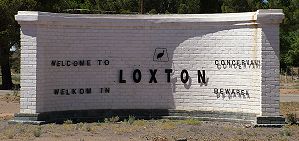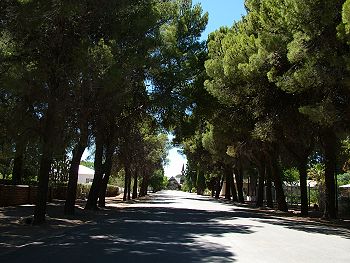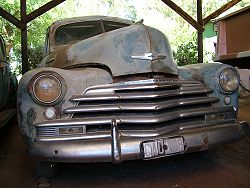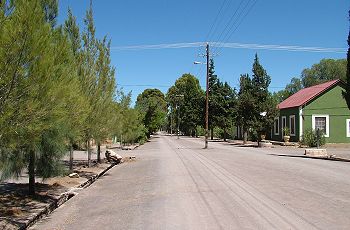
Prologue
| Day 1 | Day 2
|
Day 3 | Day 4
| Day 5 | Epilogue |
About Us | Home
Loxton
| Fraserburg | Bitterstroom
| Leeu-Gamka | Prins
Albert

Loxton
Day 3: 18 December 2005 SUNDAY
 Imagine
massive trees that cascade every street, with little Victorian houses
snuggled in fairytale gardens, and people strolling peacefully along the
streets with their dogs trailing behind, sniffing scents only enticing
to themselves. That is Loxton, a stunning, beautiful little town with
large green trees that stretch throughout it.
Imagine
massive trees that cascade every street, with little Victorian houses
snuggled in fairytale gardens, and people strolling peacefully along the
streets with their dogs trailing behind, sniffing scents only enticing
to themselves. That is Loxton, a stunning, beautiful little town with
large green trees that stretch throughout it.
I loved the wooden lanes the most, casting shadows over the whole width
of the road. Our first encounter with a local was a group of children
walking with an adult. One youngster was jumping and skipping his way,
stirring up a cloud of dust behind him. They brightened up the grey road
with their colourful clothes.
 When
we drove further through Loxton, we saw an old woman who walked around
with her dog. She looked a bit disorderly, but when we talked to her, we
discovered that she was actually from England. We found it difficult to
hold a conversation with her, or maybe it was that she just didnít want
to have a discussion with us, because she just walked, or actually
strolled on forwards to wherever her wobbled feet were taking her.
When
we drove further through Loxton, we saw an old woman who walked around
with her dog. She looked a bit disorderly, but when we talked to her, we
discovered that she was actually from England. We found it difficult to
hold a conversation with her, or maybe it was that she just didnít want
to have a discussion with us, because she just walked, or actually
strolled on forwards to wherever her wobbled feet were taking her.
If we hadnít stopped to talk to an old lady, who seemed to be absorbed
in her own thoughts, Etienne wouldnít have caught sight of old
odd-looking machinery protruding over a fence. He was immediately very
curious to find out what it was and searched for the entrance to the
property. Somehow he had a nose to sniff out the oldest things, because
we were blown-away with what we found. We found ourselves surrounded by
massive war tanks and trucks that were parked under sheds to provide
shading. Most of these vehicles were from the period of WWII, some of
these machines where old Chevyís. It was very impressive to see the
variety that had been collected in one area and the impeccable condition
they were in.
 While
we looked at the vehicles from the gate, we asked some workers who were
hammering sheets onto the sides of a shed if we could look around. They
assured us that it would be all right. So we walked inside and started
talking and looking at what we were seeing, when suddenly to our left
from inside the shed an old man came charging up to us. Very
aggressively he accused us of not introducing ourselves. I was a bit
flabbergasted by his accusations, because we simply hadnít seen him
standing behind vehicles in the shed. But when Etienne assured him we
meant no harm by walking and looking around, he decided he liked us and
started explaining to us what their aim was with the collection. They
planed on opening a museum to attract more tourists to Loxton. It was
very impressive, for one, to be able to find so many old artefacts and
that some of the vehicles still work! If Iím not mistaken, I think
almost all of them actually still work.
While
we looked at the vehicles from the gate, we asked some workers who were
hammering sheets onto the sides of a shed if we could look around. They
assured us that it would be all right. So we walked inside and started
talking and looking at what we were seeing, when suddenly to our left
from inside the shed an old man came charging up to us. Very
aggressively he accused us of not introducing ourselves. I was a bit
flabbergasted by his accusations, because we simply hadnít seen him
standing behind vehicles in the shed. But when Etienne assured him we
meant no harm by walking and looking around, he decided he liked us and
started explaining to us what their aim was with the collection. They
planed on opening a museum to attract more tourists to Loxton. It was
very impressive, for one, to be able to find so many old artefacts and
that some of the vehicles still work! If Iím not mistaken, I think
almost all of them actually still work.
He told us how difficult it was for them to import some of the
machinery, because the government would sometimes get suspicious of
their intensions. At one stage they thought he wanted to start a
 mini
war with all the things he had there, and Iím sure it would actually be
possible! But he assured them that his only intension was to build up a
collection of war vehicles.
mini
war with all the things he had there, and Iím sure it would actually be
possible! But he assured them that his only intension was to build up a
collection of war vehicles.
They had obviously put a lot of planning into the museum, because a
guest house had been built right next to the would-be museum, and they
were very friendly and invited us to tea, which we unfortunately had to
decline because we had just eaten some snacks on the road to Loxton.
The old man had a lot of things to attend to, so he excused himself and
went on to do what he had to do. Another younger man, Kevin then came
over to talk to us. He told us that the Karoo was the ideal setting to
preserve artefacts, because it doesnít rain which causes erosion. He
showed us a tank which they were busy restoring. They were actually
planning on fixing it so that it would work again. I was quite
impressed, and would have liked to see this massive tank strolling
through the sleepy streets of Loxton. What an image that would have
been! They would just have to mind the telephone poles, which for some
or other reason stood in the centre of all of the roads. These poles
standing in the middle of the road could be seen in most of the Karoo
towns.
 We
left them to carry on with their work to drive through Loxton. The
centre of town boasts a beautiful church made of stone cladding with a
creeper growing on it. Since it was Sunday morning, we stopped so that I
could take a photograph of the church and we heard the church bell ring
and the congregation left the building. We saw a family driving very
slowly in their car down the streets, and funnily enough, a young boy
was running after them trying to catch up to them. They were obviously
teasing him, because whenever he nearly reached the car they drove
faster and the boy just laughed. He saw us looking questioningly at him,
but he just laughed and shrugged his shoulders and ran on. It was
clearly a town with a lot of spirit and determined people. The only
thing they did lack was supplies in their cafť. This was a constant
drawback throughout our excursion, but we somehow managed to find what
we looked for just before we completely run out of stock.
We
left them to carry on with their work to drive through Loxton. The
centre of town boasts a beautiful church made of stone cladding with a
creeper growing on it. Since it was Sunday morning, we stopped so that I
could take a photograph of the church and we heard the church bell ring
and the congregation left the building. We saw a family driving very
slowly in their car down the streets, and funnily enough, a young boy
was running after them trying to catch up to them. They were obviously
teasing him, because whenever he nearly reached the car they drove
faster and the boy just laughed. He saw us looking questioningly at him,
but he just laughed and shrugged his shoulders and ran on. It was
clearly a town with a lot of spirit and determined people. The only
thing they did lack was supplies in their cafť. This was a constant
drawback throughout our excursion, but we somehow managed to find what
we looked for just before we completely run out of stock.
It was approximately 103km from Loxton to Fraserburg.
* * * * *
A Short History:
In 1899, Loxton was established as a Ned. Geref. Churchtown in a (duik)
in the Sakriviervallei and in 1905 became a municipality. Although itís
usually a warm, sleepy place with a shortage of water, a flood in 1961
caused so much damage that three quarters of the buildings had to be
rebuilt.
Additional Pictures:
![]()
Forgotten
Towns of the Karoo
Web Design © CoZania.co.za
March 2006







